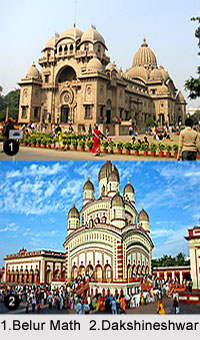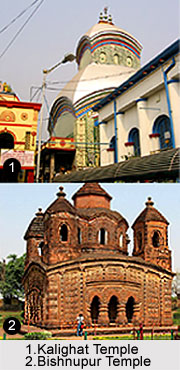 Temples of West Bengal show the rich culture and tradition of the state. Most of the temples are found here in a ruined state, partly due to the work of nature and also in some part an outcome of the work of man. Of the ruined temples in Bankura district and Burdwan district, enough remains to establish their kinship with the virile architectural movement in Orissa which produced the temples at Bhubaneswar.
Temples of West Bengal show the rich culture and tradition of the state. Most of the temples are found here in a ruined state, partly due to the work of nature and also in some part an outcome of the work of man. Of the ruined temples in Bankura district and Burdwan district, enough remains to establish their kinship with the virile architectural movement in Orissa which produced the temples at Bhubaneswar.
A group of temples at Barakar in Burdwan is believed to have been built in the 10th and 11th centuries by the Pala kings of Bengal. These are locally known as the Begunia group on account of their fancied resemblance to the fruit of egg plant. The Siddheswara temple at Behulara in the Bankura district dates from the 10th century and is the most ornate of this group. Terracotta reliefs adorn its entire brick surface, but the lavish decoration merely emphasizes the elegance of its lines.
Along with the building movement described above, there was an indigenous style of building, approaching a kind of folk architecture, which was widely prevalent in southern Bengal. Characterised by a freshness and spontaneity, this type of structure was clearly derived from the thatched bamboo hut so common in most parts of Bengal. The curved cornice and eave, which is a special feature of these temples, are directly descended from the bamboo framework of the huts of the people, originally bent into this shape in order to throw off the frequent heavy rain.
 Bishnupur Group of Temples
Bishnupur Group of Temples
Bishnupur in the Bankura district has a group of such temples, undoubtedly built during the days of the Malla Rajas, who are known to have encouraged temple-building. The Lalgiri temple is built in laterite, has a single tower, and probably dates from 1658 A.D. The Madan Mohan temple is in brick and was erected in 1694 A.D. The Shyam Rai (1643 A.D.) and the Madan Gopal (1665 A.D.), built in brick and laterite, respectively, have five towers and are of the panchayatana type. The external decoration of these temples, particularly of those constructed in brick, consists of square panels of terracotta reliefs, the subject-matter of which is often secular and thus of considerable sociological interest.
The jor-bangla or double temple is a structural variation of the same type and resembles two thatched huts joined together and surmounted by a single tower. The Krishnaraya temple built at Bishnupur in 1726 A.D. and the Chaitanya temple at Guha-para in the Hooghly district are typical examples. A single hall or thakurbari, on one side of which is the vedi or altar, is the main feature of the interior of these buildings. Above this is an upper gallery running round the circuit of the thakurbari.
Temples of Lakhnauti
The temples at Lakhnauti, which was the capital of the Sena rulers, were built of black basalt obtained from the neighbouring Rajmahal hill. These ornate structures were despoiled by the Muslims in 1197 A.D. and their remains were used to build a Muslim capital at Gaur. The temples of Varendra (Northern Bengal) were similar in many respects to the Mahabodhi temple at Bodh Gaya. The masons of the Vishnu temples of the 11th and 12th centuries joined the courses of their stones by means of molten metal. In what is now the Mazar of Zafar Khan Ghazi at Tribeni in the Hooghly district, two compartments have been identified as the antatrala and mandapa of a Vishnu temple of the Lakhnauti style, and therefore of the Pala-Sena period..
Temples of Goddess Kali
Of comparatively recent temples near Kolkata, that of the Goddess Kali in the Kalighat area, the Dakshineshwar temple of Kali, where Sri Ramakrishna paramhansa was once the pujari, the Belur temple, four miles north of Howrah and the temple of Lord Vishnu is note-worthy.
Hanseswari temple is a Hindu Temple of goddess kali in the town of Banshberia at Hooghly District. The temple complex has another temple - Ananta Basudeba temple - besides the main temple. The architecture of the temples is the representation of Tantrik Satchakrabhed.
Other Temples of Kolkata
There are four Jain temples built in the late 19th century in Badridas Temple Street in Kolkata. The most important of these is dedicated to Shree Sheetalnathji, the tenth of the twenty-four Jain deities.
Important temples in the district include the Bakranath Temple at Bakreswar, Bansuli Temple at Nannur, Bargabhima Temple at Tamluk, Brindabanchandra Temple at Guptipara, Chinese Temple at Achipur, Dhirdham Temple at Darjeeling, Ekteswara Temple at Ekteswara, Jagannath Temple at Serampore, Jain Temple Ruins at Boram, Jain Temples at Deoli, Jateshwarnath Temple at Mahanad, Kalna Shiva Temples at Kalna, Kanak Durga Temple at Chikligarh, Kiriteshwari Temple at Murhsidabad, Krishnarjun Temple at Tamluk, Malleswar Temple at Chandrakona, Radha Kanta Jiu Temple at Rajbalhat, Sarva Mangala Devi Temple at Garbeta, Shivakhya Devi Temple at Amaragarh.











